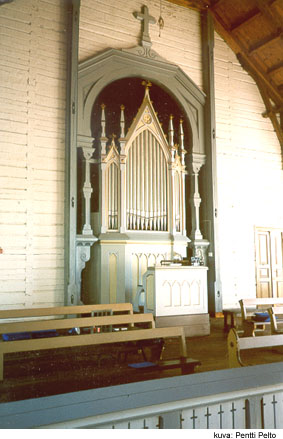|
HISTORICAL ORGANS IN FINLAND 
Luhanka Church- Jurva, Juho Albanus 1897
- 18 stops, 2 manuals and pedal
- mechanical action and mechanical stop action
Luhanka Church is one of the largest wood churches in Finland. It was built to a plan by Josef Stenbäck in 1891-93, representing an attempt to transpose the shapes and volumes of brick Gothic into a wood structure. The church is currently only used in summer; it is not heated in winter.
The organ, built by Albanus Jurwa, is situated in the spacious steeple chamber behind the loft. Only the façade and the console in front of it are visible from the church. The organ has been spared major changes. A blower has been added, and the lost Trompete stop on Manual I has been replaced with another, stylistically appropriate trumpet stop.
Luhanka Church and its organ form a stylistically coherent entity, which adds to the historical value of the instrument. Apparently most of the components for the Luhanka organ were ordered ready-made by Albanus Jurwa from the Walcker factory. The organ thus represents the style of German builder E.F. Walcker in Finland.
Appearance
The façade consists of a large A-shaped flat and two small oblique flats flanking it. They are all topped with a pediment. The façade framework and its decoration are in the Neo-Gothic style. The organ looks rather small because of the large size of the church.
The chest of Manual I and an access space for tuning the trumpet stop are immediately behind the façade. Behind these are the swell box for Manual II and, furthest back, the Pedal chest. There is plenty of space around the organ in the steeple chamber; because of this, the organ has back and side walls, although these cannot be seen from the church.
Technical features
The windchests are of the mechanical cone-chest type developed by E.F. Walcker. This organ is the only one in Finland apart from the Jurwa organ in Sauvo to have retained an original chest of this type. The rollers are on two levels, this being the only way to make the treble-side division sufficiently closely spaced.
Under the chests lies a single large double rise reservoir. Attached to its lower frame are two pedal-operated wedge-shaped feeder bellows. These are still in working order, although the organ has been fitted with a blower. The action is fully mechanical and principally made of wood.
The console is a separate element in front of the organ. The organist sits facing the church. The keyboards have celluloid and ebony coverings, and the stop knobs are fairly small and placed beside the keyboards. The stop action is fully mechanical.
Musical properties
The organ is light and easy to play, since the Walcker cone chest functions almost frictionlessly and requires no great force. The touch lacks the ‘pluck’ typical for a slider chest. The valves on a cone chest open at slightly different times, rendering a soft touch. Because the stop knobs only operate a single valve in the stop channel, the stop action is light to the touch as well.
Manual I has a powerful and carrying tone, while Manual II is softer and lyrical, suitable for accompaniments and preludes. The disposition of Manual I has no 2’ stop, while all stops on Manual II are 8’. The Luhanka organ has all the accessories that money could buy at the turn of the 20th century to make the organist’s job easier. The sound of the organ is clearly Walckerian, although certain variations typical for Albanus Jurwa are audible. The pipes are tuned using tuning slots as is typical for the period of their construction.
Disposition
Manual I C-f3 | Manual II C-f3 | Pedal C-d1 |
Bordon 16’ | Geig.principal 8’ | Violon 16’ |
Principal 8’ | Liebl.gedackt 8’ | Subbass 16’ |
Consertflöte 8’ | Salicional 8’ | Violoncello 8’ |
Viola di Gamba 8’ | Aeoline 8’ | Posaunenbass 16’ |
Quintatön 8’ | Voix celeste 8’ | I/Ped |
Oktav 4’ | II/Ped | |
Rohrflöte 4’ | | |
Mixtur 3chor 2 2/3’ | | |
Trompete 8’ | | |
II/I | | |
I 4’ | | |
| | |
| | |
|
|
|
Fixed groupings: piano, mezzoforte, tutti | | |
Manual II in swell box | | |
| | |
| | |
| | |
| | |
| | |
| | |
| | |
| | |
| | |
| | |
| | |
|